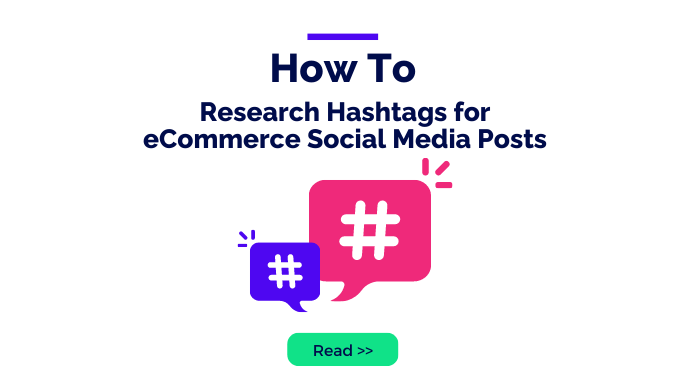How Do I Choose a Hashtag for My Business?
In e-commerce, getting noticed is an art as much as a science. Without strategic promotion, even if you’re selling the most spectacular jewelry or your beauty product is an elixir for eternal youth, your business could still fade into obscurity. How do you make sure you catch the audience’s eye? We all know that beautiful product photos will catch attention, however, by understanding and employing the humble hashtag. Creating the right hashtags and SEO and image SEO strategy for your e-commerce business can propel your products into the spotlight and earn you the attention and sales your products deserve.
Now, finding those magic hashtags isn’t as easy as slapping a ‘#’ before a relevant word. It requires you to examine your niche and skillfully research social media trends.
Methods To Find The Best Hashtags In Your E-Commerce Niche
Use Online Tools
The internet is brimming with useful tools designed to help you uncover the most relevant and on-the-rise hashtags for your e-commerce niche. Twitter’s “Explore” feature can reveal trending topics in your area and around the world, which could be a valuable resource for a location-specific e-commerce business. Instagram also offers an “Explore” page, where you can spot the most popular hashtags in any niche on Instagram, if that’s your niche. Facebook’s “Trending” section, though less hashtag-focused, can still provide insights into what’s currently captivating the audience.
Google Trends is an excellent research tool, showing you how popular certain topics are at the moment, while Exploding Topics can reveal what’s just starting to pick up steam in a variety of niches. With Hashtagify, you can discover related hashtags and their popularity rankings. For example, if you’re in fashion photography, Hashtagify could show you that #fashionphotography and #fashiongram are among the most relevant hashtags for fashion photography.
Research your competitors
There’s no harm in keeping a watchful eye on the hashtags your competition uses. By observing their trends, you can gain insights into the hashtags that resonate with your market niche and capture your audience’s attention.
Use niche-specific hashtags
You can highlight your unique offerings by using hashtags that relate directly to your niche. For instance, if your passion is crafting handmade candles, champion hashtags like #handmadecandles, #soycandles, and #solidbeeswaxcandles.
Go local with your hashtags
If your e-commerce venture has a geographical focus, it’s a good idea to incorporate location-specific hashtags. If your handmade jewelry business is based in London, you could consider hashtags such as #londoncandles and #handmadeinlondon.
Analyze The Performance Of Your Hashtags
Now that you’ve identified and selected a number of hashtags that resonate with your target audience and align with your product, it’s time to put them into action and analyze their performance.
Here are some tips for analyzing the performance of different hashtags for your e-commerce niche:
- Use hashtag tracking tools: Tools like Social Searcher, Hashtags.org, and RiteTag are super useful. They allow you to monitor how various hashtags perform within your e-commerce niche.
- Monitor engagement: Pay close attention to the engagement your posts receive when different hashtags are used. This insight will let you pinpoint which hashtags are creating a buzz and capturing your audience’s attention.
- Analyze reach: Use analytics tools to analyze your posts’ reach when using different hashtags. This intel will clue you in on hashtags that have the potential to increase your online visibility.
- Experiment with hashtags. Don’t shy away from new hashtags. By experimenting, you could stumble upon fresh hashtags that align perfectly with your audience’s preferences, driving engagement.
Avoiding Common Hashtag Mistakes
Let’s talk about some golden rules when it comes to hashtag usage, especially if you want to increase your brand’s visibility. So, here are some pitfalls to avoid:
- Try to avoid using lengthy hashtags. The most successful ones are usually short, snappy, and easy to remember. It’s all about being catchy yet concise.
- Steer clear of hashtag clutter. Overloading your posts with too many hashtags might confuse your audience and dilute your message. So, remember, less is often more.
- Keep your hashtags clear and direct. Vague expressions may not serve your purpose well. It’s all about making sure your message hits home.
- Instead of sticking your brand name into a hashtag, think outside the box. Try to encapsulate what your brand stands for or even the essence of your specific campaign. It can be a lot more effective!
- Keep your hashtags relevant. Don’t just include a hashtag because it’s trendy. It needs to have a connection to your content, or it can confuse and alienate your audience.
- Don’t hijack trends. On the topic of trendy hashtags, it’s usually not a good idea to ‘hijack’ popular ones that don’t relate to your content. The relevance of your hashtags is key to ensuring they work in your favor.
- Don’t just sit back and wait for your hashtags to take off. Be proactive! Stir up some conversation, encourage sharing, and really drive that engagement. This can give your hashtag campaign the momentum it needs.
Hashtags are a powerful tool in your e-commerce marketing strategy, but they need to be used wisely and authentically. Follow these guidelines, and you’ll be on the right path to making your products and brand more visible and engaging to your target audience.
Interested in learning more….
- Image matters: Upgrade Furniture Photography with AI backdrops
- How to Test AI Product Photos: 5 eCommerce Measurement Tools
- Boost Your Image SEO with AI-Generated Images
- Leveraging AI Product Image Generator for eCommerce Sites & Digital Product Catalogs
- Reducing Photography Costs with AI for Product Photography
